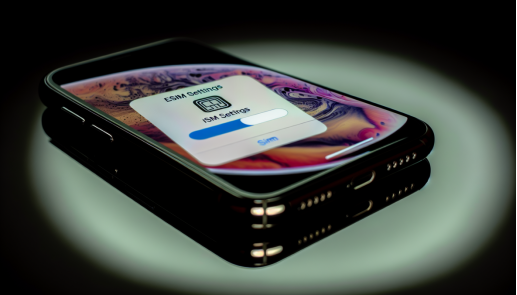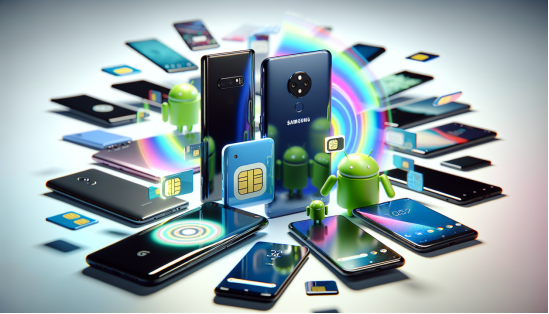Is My Phone eSIM Compatible? The Ultimate Guide to Checking Your Device in 2024
Dec 26,2023 | James
In this digital age, the ability to stay connected is more crucial than ever. One technology that has revolutionized our connectivity options is the eSIM. But how can you determine if your device is equipped to handle this cutting-edge technology? Let’s dive into the world of eSIM compatibility and unravel the mystery together by asking, “is my phone eSIM compatible?”
Understanding eSIM Technology

The eSIM technology enables you to move between different cellular networks without having to replace your physical SIM card. This digital version eliminates the need for an actual plastic or paper device, instead being built into one’s phone itself – offering convenience and flexibility so that consumers don’t have any ties due to a single network provider.
What Is an eSIM?
An eSIM, or embedded SIM, is a digital alternative to traditional physical SIM cards. It offers greater compatibility flexibility, enhanced durability, and robust security measures. Unlike physical SIM cards, eSIMs eliminate the need for manual swapping, allowing for digital updates.
With eSIMs, users can seamlessly activate mobile plans from different carriers without the hassle of purchasing physical SIM cards. The digital nature of eSIMs facilitates a smooth transition between carriers, as devices can store multiple carrier profiles.
One significant advantage is the convenience of managing multiple mobile plans simultaneously, making eSIMs ideal for frequent travelers or those needing separate lines for personal and work use. Overall, eSIM technology provides a more streamlined and flexible approach to mobile connectivity.
Checking eSIM Compatibility for iPhones

Apple’s flagship series since 2018, the iPhone XS, has been incorporating the technology of esim. Compatibility depends on location as well as carrier so specific factors need to be taken into consideration.
So let’s have a closer look at which models can use an embedded SIM card and how one would go about checking its availability for their device in particular.
iPhone eSIM Compatibility Models
When dealing with eSIM technology, iPhones from the XS series (including XS Max and later models) are deemed compatible. However, compatibility may vary based on location and carrier. To ascertain whether an iPhone supports this system, consumers are advised to consult their device manufacturer's website, reseller, or network provider. This step is essential for understanding how to correctly activate and utilize eSIM features.
To provide more precise information, iPhones from the 11 Pro model onward inherently support eSIM technologies. Nevertheless, approval for such services may not be confirmed by all locations or carriers. It is imperative to obtain explicit confirmation from the relevant networks before effectively utilizing eSIM-enabled service plans on your phone.
How to Check Your iPhone's eSIM Compatibility
To check if your iPhone model is compatible with eSIM, just go to Settings > General > General > Check if your iPhone model is compatible with eSIM. About and scroll down the Digital SIM section. If there’s an IMEI number next to it, then you have a phone that supports this type of technology.
An alternate way is by going into Cellular settings on the device and looking for ‘Add eSIM’ option, in case that appears then congratulations as you can use this feature with ease!
Determining eSIM Compatibility for Android Devices

Shifting our focus to Android phones, the assessment of their eSIM capability follows a methodology similar to that employed for iPhones. However, owing to the multitude of Android models in circulation, slight variations may exist. In subsequent sections, we will delve into the compatibility of different brands, including Samsung Galaxy and Google Pixel, in relation to eSIM usage.
Samsung Galaxy eSIM Compatibility
Certain Samsung Galaxy models support eSIM technology. This includes some versions of the S20, S21, Z Flip and Note 20 series as well as from their A range. Each model’s availability for eSIM differs depending on region so it is advised to first check your device settings or consult your carrier or manufacturer if unsure.
Under ‘Connections’ in phone’s Settings followed by SIM card manager lies an option labeled “Add eSIM” – this indicates that esim-functionality has been enabled for such particular phone type. It may therefore be concluded that when looking at whether a specific Samsung smartphone supports its own integrated sim solution one should check with either Carrier/manufacturer website directly through detailed inquiries -or easily determine the correct answer according to respective handset information displayed under ‘Settings’.
Google Pixel eSIM Compatibility
Google’s Pixel phones, from the 4 series onward, including ‘a’ devices, all offer eSIM capability. But like Samsung handsets, older models may only support this feature in select locations and carriers. To determine if your Google-made phone is esim compatible. Go to Settings and look for Dual SIM/eSim selection, which indicates readiness for such service. It could be worth checking with your carrier before attempting any change that concerns Sim cards or settings related to them.
Other Android Brands and eSIM Compatibility
When it comes to eSIM compatibility, many Android phones to Samsung Galaxy and Google Pixel support the technology. These include Xiaomi 12T Pro, Huawei (select models), Oppo (selected models) as well as Motorola’s select models. All these devices are compatible with your preferred mobile network when using an iPhone or Android device which supports esims for this purpose. It is important to confirm that a specific model from each brand will indeed work on your carrier since such features may differ based on region. Contact either the maker or service provider of any android phone you intend to buy so make sure they have what is needed for reliable support of esim technology before committing yourself.
Verifying Carrier Support for eSIMs

-
Besides having a capable phone, you also need to make sure your carrier has support for esim networks before using its capabilities.
Carrier Locked vs. Carrier Unlocked Phones
Unlocked phones provide an advantage for the use of eSIM since they do not have any restrictions related to network. Unlike carrier-locked phones, which are linked solely with a specific service provider’s network, device users can switch between different carriers due to the fact that unlocked mobiles offer no such limitations. Thus it is evident why people who prefer flexibility in terms of their phone’s connectivity should opt for these kinds of devices when using esim technology.
Confirming eSIM Support with Your Carrier
When considering a carrier-unlocked or unlocked device for use with an esim, the next step is to confirm that your specific phone has access to this technology. Typically, all large carriers support eSIMs including: AT&T, T-Mobile, Verizon, Google Fi and more such as Mint Mobile, Visible, US Cellular, etc.
Many current phones are now compatible with esim capabilities, allowing you take advantage of them if they’re supported by your model of choice, be sure to check specifications before purchasing any new devices!
Activating and Managing eSIMs on Your Device

After confirming that your device and carrier are both compatible with eSIMs, you can begin to activate it on the desired device.
Activating an eSIM on iPhone
-
Go into Settings and select either ‘Mobile Data’ or ‘Cellular’
-
Pick the option of ‘Add Cellular Plan’
-
Follow the instructions on-screen for scanning the QR code provided by your carrier or enter a given activation code.
Activating an eSIM on Android
If you are an Android user, here is the process to activate eSIM.
-
Go into Settings
-
Select ‘Network & internet’
-
Look for SIMs and follow directions on screen
-
Utilize device camera to scan QR code given by your carrier
If any issues occur with incompatibility or connection, take a break before trying again. Resetting network settings could help too, as well as talking with service provider if needed.
Managing Multiple eSIMs
Using eSIM technology, it’s easy to switch between different carriers on your device. In Settings > Cellular or Mobile Data, select the number you want to use and make sure only one is active at a time for data purposes. To manage multiple eSIMs stored on your device, adjust which one is currently enabled for data access or delete any unused profiles from settings.
Troubleshooting eSIM Compatibility Issues
eSIM technology has its advantages and is convenient. Some challenges can arise when attempting to use it with your device. These issues may be caused by either the carrier or limitations in the hardware of said device. We have provided a few pointers below that should help you address common eSIM compatibility problems successfully.
Resolving Carrier-Related Issues
Common issues with eSIMs include SIM restrictions, device-carrier incompatibilities, and network coverage problems while roaming. To tackle these concerns, we recommend reaching out to your service provider's customer support for assistance. They can guide you through any available updates that may resolve compatibility difficulties, addressing carrier-related matters.
Overcoming Device Limitations
If a device does not support eSIM or has limited capacity for multiple profiles, the user may need to upgrade their equipment. eSIM compatibility is determined by how compatible and versatile a particular device is. If it doesn’t have the necessary features, making alterations could be an approach.
Conclusion
In conclusion, eSIM technology is gaining popularity for its convenience and versatility, eliminating the need for physical SIM cards. It simplifies carrier switching, allowing a single device to handle multiple plans seamlessly. To maximize these features, ensure both your device and service provider support eSIMs. Our detailed guidelines offer insights into verifying eSIM compatibility for Android or iPhone devices, checking carrier availability, and instructions for activating/managing this digital card format. We also provide solutions for any hiccups that may arise during these tasks. With our assistance, now is an excellent time to embrace modern network access through robust eSIM capabilities!
Frequently Asked Questions
How do I know if my phone supports eSIM?
To ascertain if your Google Pixel mobile supports eSIM technology, open Settings > Network & Internet and tap ‘eSIM Cards’. Look for the choice labeled “Download a SIM instead?” If it’s present, then your device is fit to employ eSIM.
What mobile phones are compatible with eSIM?
Many phones and tablets that utilize the Android operating system can take advantage of esim technology for an easier set up process as well as greater flexibility. Likewise, iPhones are also equipped to support this same feature, which makes it easier to manage one’s mobile usage.
What is an eSIM?
The eSIM is an electronically rewritable SIM card, providing a more convenient way to connect with your carrier as it does away with needing physical nano-SIM cards. The digital alternative simplifies the process of activating cellular plans without dropping any important pieces of information in the process.
How can I activate an eSIM on my Android device?
Activate your eSIM on your Android device by going into the Settings app, selecting ‘Network & internet’, and then ‘SIMs’ to follow the on-screen instructions.
Can I use multiple eSIMs on my device?
It is possible to utilize multiple eSIMs on your device for accessing data services from various providers, being able to switch between them at ease.



